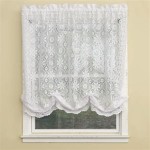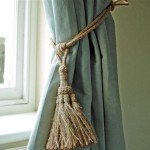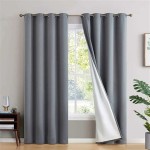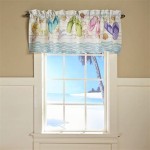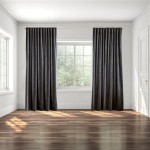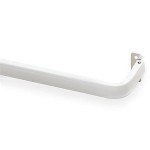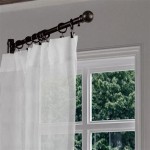How To Hang Curtains In A Rental
Hanging curtains in a rental property presents a unique set of challenges. Renters often face restrictions on making permanent alterations to walls, which makes traditional curtain hanging methods like drilling holes and installing hardware problematic. Furthermore, renters may want to avoid damaging walls to ensure retrieval of their security deposit upon moving out. This article provides comprehensive guidance on hanging curtains in a rental property without causing damage, covering various methods, considerations, and best practices.
Key Considerations Before Hanging Curtains
Before commencing any curtain hanging project in a rental, several factors merit careful consideration. Understanding these aspects will significantly impact the choice of method and the overall success of the installation.
Lease Agreement Review: The first and most crucial step is to meticulously review the lease agreement. Specific clauses may explicitly address alterations to the property, including nail holes, adhesive usage, and paint modifications. Prioritize adhering to these stipulations to avoid potential lease violations and associated financial penalties. Should the lease agreement be ambiguous or unclear, contacting the landlord or property manager for clarification is always advisable. Obtain any approvals in writing to maintain a clear record of consent. This proactive approach minimizes the risk of future disputes regarding property alterations.
Window Measurements: Accurate window measurements are essential for selecting the appropriate curtain size and rod length. Measure the width and height of the window frame meticulously. When measuring the width, extend the measurement beyond the frame on each side to allow for adequate curtain coverage and prevent light leakage. For height, consider the desired placement of the curtain rod. Hanging the rod higher than the window frame creates an illusion of greater height within the room. Note all measurements in both inches and centimeters for versatility when shopping for curtains and hardware. Proper measurements prevent the frustration of purchasing incorrectly sized items.
Curtain Weight and Fabric: The weight and fabric of the curtains significantly influence the choice of hanging method. Lightweight fabrics like voile or sheer materials require less supportive hardware and are well-suited for damage-free solutions. However, heavier fabrics such as blackout curtains, velvet, or lined drapes demand more robust support. Consider the overall weight distribution when selecting a hanging method to ensure stability and prevent potential accidents or damage. If opting for heavier curtains, explore multiple lightweight options combined for privacy or light control instead of a single heavy layer.
Light Control and Privacy Needs: The purpose of the curtains within the room will also influence the selection process. For bedrooms, blackout curtains might be a priority to ensure darkness for sleep. Living rooms often require curtains that provide privacy while still allowing some natural light to filter through. Bathrooms necessitate moisture-resistant fabrics that offer complete privacy. Carefully evaluate the room's specific needs before choosing curtain types and corresponding hanging methods.
Damage-Free Curtain Hanging Methods
Several damage-free methods allow renters to hang curtains without compromising the integrity of the property's walls. These methods typically utilize adhesive solutions or tension mechanisms, minimizing the risk of permanent alterations.
Tension Rods: Tension rods offer a simple and reversible solution for hanging lightweight curtains within a window frame. These rods utilize a spring-loaded mechanism to create pressure against the inner frame of the window, effectively holding the rod in place. Tension rods are particularly suitable for lighter fabrics like sheers or lace curtains. To install a tension rod, measure the distance across the inside of the window frame. Choose a tension rod that is slightly longer than this measurement. Compress the rod and position it within the frame, ensuring it is level. Gradually release the rod, allowing the spring mechanism to expand and secure it firmly against the frame. Periodically check the tension to ensure the rod remains securely in place and readjust if necessary.
Command Hooks: Command hooks are adhesive-backed hooks that can be used to hang lightweight curtain rods or directly support curtain panels. Command hooks are available in various sizes and weight capacities, making them versatile for different curtain styles. Select command hooks that are rated to support the weight of the curtains and rod. Before attaching the hooks, thoroughly clean the wall surface with rubbing alcohol to remove any dust or residue. Peel the backing from the adhesive strips and firmly press the hooks against the wall for the recommended duration specified by the manufacturer. Allow the adhesive to cure for the recommended time before hanging the curtains. Distribute the weight evenly across multiple hooks for added stability. Exercise caution when removing command hooks to avoid peeling paint or damaging the wall surface.
Magnetic Curtain Rods: Magnetic curtain rods are designed for use on metal surfaces such as steel doors or metal window frames. These rods utilize strong magnets to adhere securely to the metal surface, eliminating the need for drilling or adhesives. Magnetic rods are particularly useful for hanging curtains in kitchens, entryways with metal doors, or in metal-framed windows. Ensure that the surface is clean and free of debris before attaching the magnetic rod. Align the rod horizontally and firmly press it against the metal surface. Periodically check the magnets' grip to ensure they remain securely attached. Choose magnetic rods with sufficient weight capacity to support the chosen curtains.
No-Drill Curtain Rod Brackets: Certain manufacturers offer no-drill curtain rod brackets that utilize adhesive strips or clamping mechanisms to attach to the window frame. These brackets provide a more permanent-feeling solution compared to tension rods while still avoiding damage to the wall. Installation instructions vary depending on the specific product, so closely follow the manufacturer's guidelines. These brackets are generally designed for lighter-weight curtains, so consider this factor when selecting the curtains.
Using Pre-Existing Infrastructure: Consider adapting existing features to hang curtains. For example, if there are existing blinds, lightweight curtains can sometimes be attached to the blind headrail with clips or hooks. Similarly, if there are existing picture rails, it may be possible to hang curtains from them using specialized hooks that are designed to hold weight. This approach saves time, effort, and avoids adding new hardware.
Choosing the Right Curtains and Hardware
Selecting the appropriate curtains and hardware is crucial for achieving the desired aesthetic and functionality while minimizing the risk of damage to the rental property. The weight of the curtains and the overall style should complement the chosen hanging method.
Lightweight Fabrics: Opting for lightweight fabrics like sheers, voiles, or lace significantly reduces the strain on damage-free hanging methods. These fabrics are less likely to cause adhesive failures or tension rod slippage. Lightweight curtains can be easily managed with command hooks, tension rods, or magnetic rods. Furthermore, they are often more affordable than heavier fabrics, making them a budget-friendly option for renters.
Curtain Panels with Grommets or Tabs: Curtains with grommets or tab tops are easy to hang on rods and distribute weight evenly. Grommets provide a smooth gliding action and prevent the rod from catching or snagging on the fabric. Tab tops offer a more casual and relaxed look. These styles are compatible with a range of hanging methods and hardware types.
Adjustable Curtain Rods: Adjustable curtain rods offer flexibility in terms of length and placement. These rods can be easily extended or retracted to fit different window sizes. Adjustable rods are particularly useful for renters who may move frequently and need to adapt their curtains to various window dimensions. Select adjustable rods made from lightweight materials like aluminum or plastic to minimize weight and strain on the hanging supports.
Consider Color and Pattern: While practical considerations are paramount, the aesthetic impact of the curtains should not be overlooked. Choose colors and patterns that complement the existing decor of the rental property. Neutral colors like white, beige, or gray are versatile and blend seamlessly with a variety of styles. Bold patterns can add visual interest and personality to a room. Ensure the chosen curtains align with the overall design aesthetic of the space while adhering to any restrictions outlined in the lease agreement regarding color or pattern limitations.
Removing Curtains and Hardware Without Damage
Proper removal of the curtains and hardware is just as important as the initial installation. Taking precautions during removal minimizes the risk of damage to the walls and ensures the retrieval of the security deposit.
Command Hook Removal: When removing command hooks, slowly and gently pull the adhesive strip downward, following the manufacturer's instructions. Avoid jerking or pulling the hook directly away from the wall, as this can cause the paint to peel. If the adhesive strip breaks, use a hairdryer to gently warm the remaining adhesive before attempting to remove it. Warming the adhesive softens it, making it easier to peel away from the wall without causing damage. If any adhesive residue remains, gently rub it off with a soft cloth dampened with rubbing alcohol or adhesive remover.
Tension Rod Removal: To remove a tension rod, carefully compress the rod and gently pull it away from the window frame. Avoid scratching or denting the frame during removal. If the rod is stuck, gently tap it with a rubber mallet to loosen it. Once the rod is removed, inspect the window frame for any signs of damage. Clean any residue or marks with a mild detergent and water.
Inspecting for Damage: After removing the curtains and hardware, thoroughly inspect the walls and window frames for any signs of damage. Look for peeling paint, adhesive residue, scratches, or dents. If any damage is found, attempt to repair it using appropriate methods. For minor scratches, use a touch-up paint that matches the wall color. For adhesive residue, use an adhesive remover. For larger areas of damage, consult with the landlord or property manager before attempting repairs to ensure compliance with lease agreement requirements.

Budget Friendly Curtains Window Treatments That Look High End

How To Hang Curtains Without A Rod 5 Alternative And Easy Ideas

How To Hang Curtains Using Command Hooks The Happier Homemaker

Curtain Installation In Al Ain Start From 150 Dirham 〣 Yahir

How To Hang Pocket Rod Curtains With A Pin Hook Diy Youtube

How To Layer Sheer Blackout Curtains

Custom Curtain Tracks Mississauga Ceiling Mounted Track

How To Hang Curtains In A Dorm

Expert Guide Curtain Installation S In Dubai Fitting Costs More

How To Hang Curtains In A Dorm

